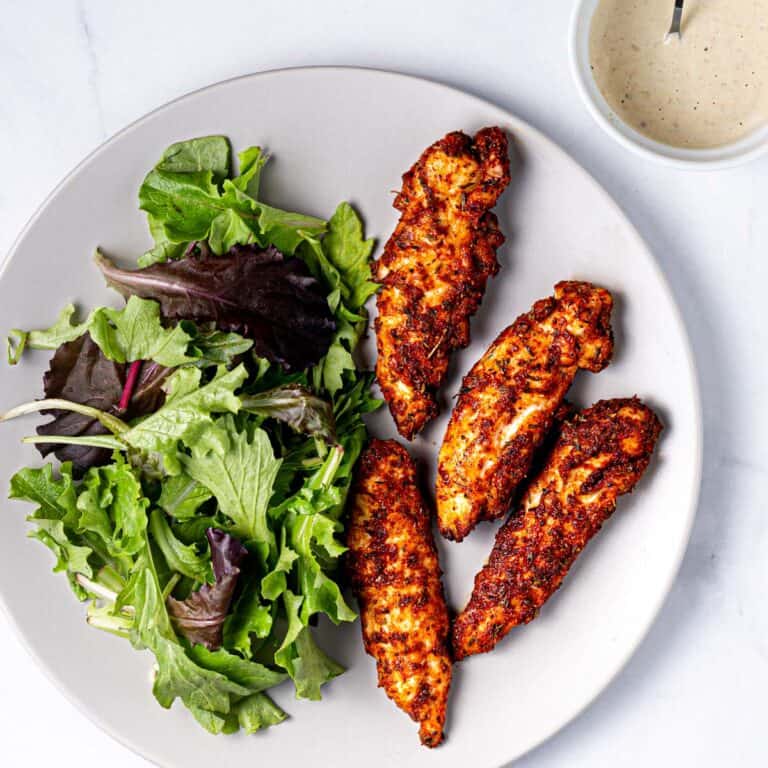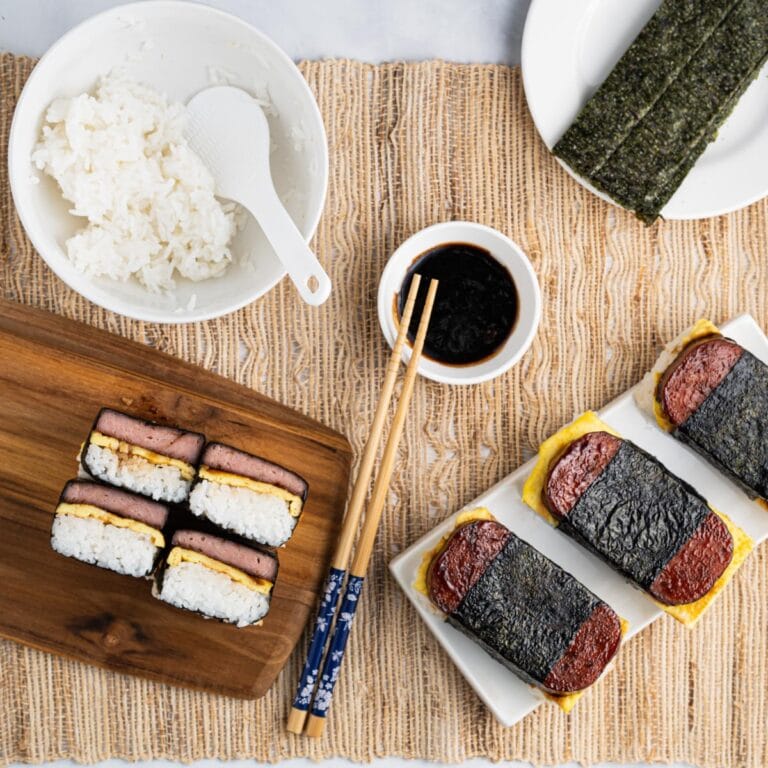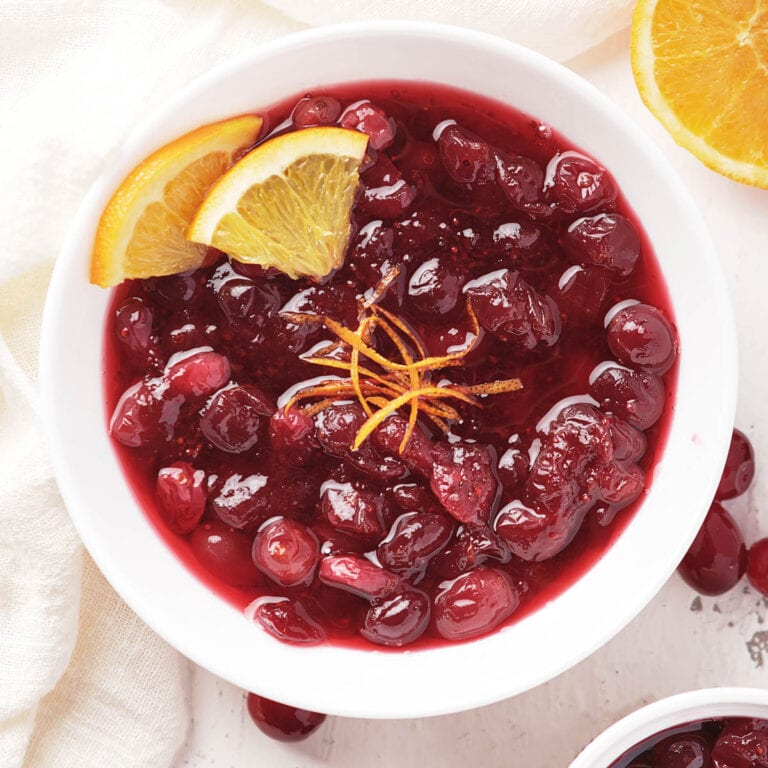Avocado Roll
This avocado roll recipe is quick, easy, and delicious. In less than 15 minutes, you’ll have velvety slices of ripe, creamy avocado nestled within perfectly seasoned sushi rice, all bundled up in seaweed.

Need a quick lunch? Avocado rolls have your back. Craving an elegant appetizer for your next dinner party? These rolls are the showstoppers you’ve been waiting for. Looking for a delightful weekend culinary project? Well, here’s your chance to master the art of sushi rolling! You can make it even better by drizzling some dragon sauce on it.
Why you’ll love this recipe
- Creamy Texture: Avocado provides a creamy and smooth texture that contrasts well with the rice and other ingredients in the roll, creating a delightful mouthfeel.
- Versatility: Avocado rolls can be customized with various ingredients such as tempura, spicy mayo, sesame seeds, or different types of fish, allowing for a personalized and diverse dining experience.
- Health-Conscious Choice: Avocado rolls provide a wholesome alternative to heavier sushi rolls that may contain deep-fried ingredients or heavier sauces, making them a healthier choice for those watching their calorie intake.
- Kid-friendly: This roll might appeal to kids for its combination of textures and mild flavors. Creamy avocado and tender rice wrapped in nori create a fun, interactive experience. Its simplicity makes it an approachable and nutritious choice for introducing kids to sushi and healthy eating.
- Vegetarian or Vegan Option: Avocado rolls are typically vegetarian or vegan, making them a great option for those who follow these dietary preferences.
Kitchen tools
- Bamboo Sushi Mat: A bamboo sushi mat is essential for creating perfectly rolled sushi. Its flexible design allows you to shape and tighten the roll, ensuring a firm and uniform structure that’s hard to achieve without it.
- Plastic Wrap: Plastic wrap shields the bamboo sushi mat, preventing sticking and facilitating smooth rolling and easy cleanup.
Ingredients needed

- Avocado: the heart of the avocado roll, brings a rich, creamy texture and vibrant flavor. Packed with healthy fats, fiber, vitamins, and minerals, avocados elevate taste and nutrition.
- Sushi Rice: binds the avocado roll with its sticky texture and subtle vinegar tang. Opt for short-grain Japanese rice, available at Asian markets or grocery stores.
- Rice Vinegar: lends a delicate tang to avocado rolls, enhancing their flavor. Choose seasoned rice vinegar or mix your own with plain rice vinegar, sugar, and salt. Find it at supermarkets or Asian markets.
- Sugar and Salt: used to season the sushi rice, enhancing its taste and balance. Their combination creates a well-rounded flavor profile that complements the other ingredients.
- Nori Seaweed Sheets: a nutrient-rich seaweed that wraps the avocado roll, providing a subtle umami taste and essential minerals. Its crisp texture contrasts with the creamy avocado, enhancing each bite. Nori sheets can be found in Asian markets, international grocery stores, and even some mainstream supermarkets. They are often sold in packs and can be located in the international or Asian food aisle.
- For serving (optional): soy sauce, sesame seeds, wasabi, and pickled ginger.
Please scroll ⬇️ to the recipe card to see the full ingredient amounts and instructions.
How to make it
Step One: Prepare the Sushi Rice. Cook the sushi rice according to the package instructions. Once cooked, let it cool slightly.
Step Two: Season the Rice. In a small bowl, mix the rice vinegar, sugar, and salt until dissolved. Gently fold this mixture into the slightly cooled sushi rice.


Step Three: Prepare Your Work Surface. Place a bamboo sushi rolling mat on a clean surface. Cover it with a sheet of plastic wrap to prevent sticking.
Step Four: Assemble the Roll. Lay a sheet of nori seaweed on the plastic wrap-covered bamboo mat, shiny side down. Wet your fingers to prevent sticking and evenly spread a thin layer of seasoned sushi rice over the nori. (Optional: flip the rice-covered nori over.)

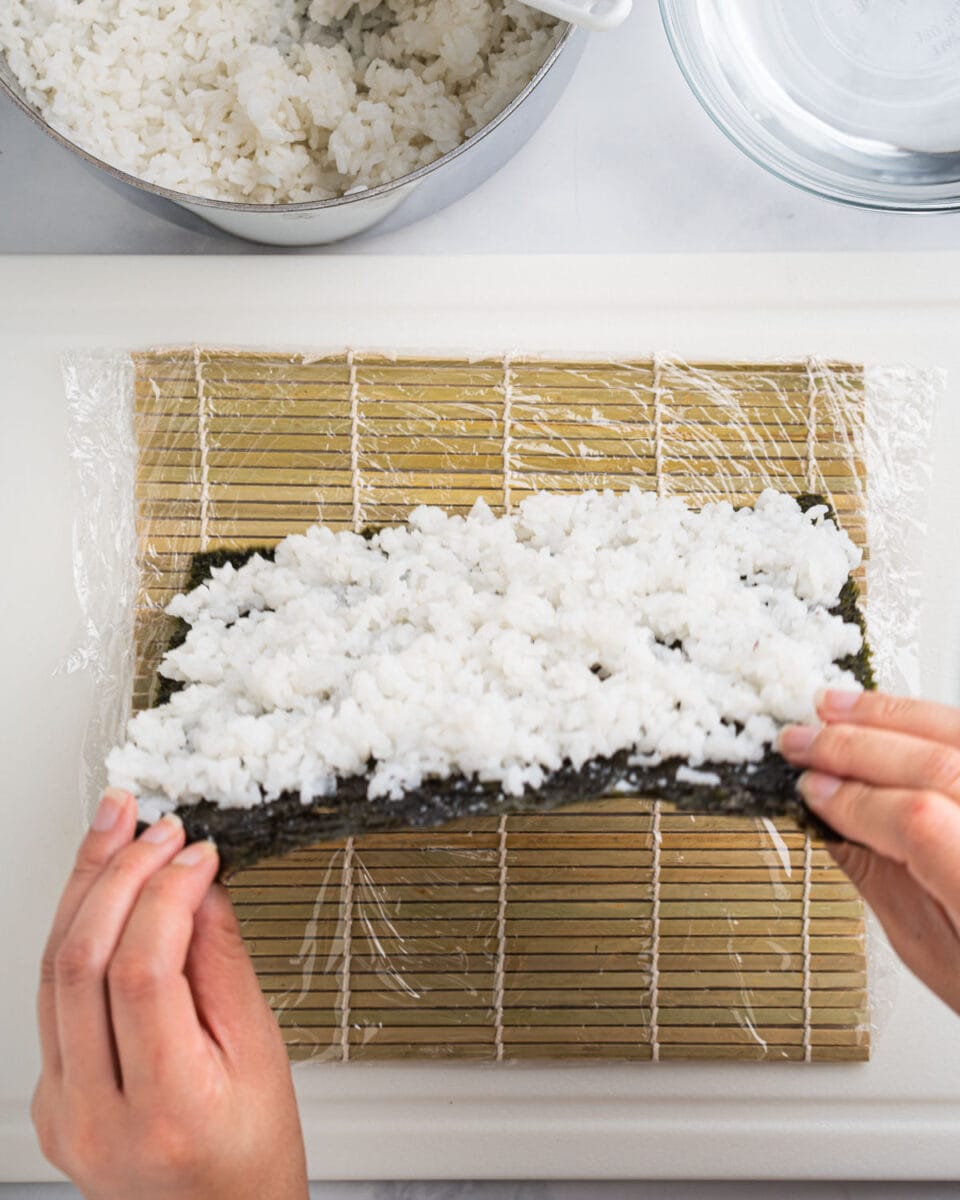
Step Five: Add Fillings. Place avocado strips in the center of the nori.
Step Six: Roll the Sushi. Using the bamboo mat, start rolling the nori from the bottom, tucking the filling in as you go. Apply gentle pressure to ensure a tight roll.


Step Seven: Slice the Roll. (Tip: cover the sushi roll with plastic wrap for easy cutting.) Using a sharp, non-serrated knife, gently slice the roll into bite-sized pieces. It’s a good idea to wet the knife between cuts to prevent sticking.
Serve and Enjoy: Arrange the avocado roll pieces on a plate, and serve with soy sauce for dipping. You can also add optional garnishes like sesame seeds, wasabi, and pickled ginger.
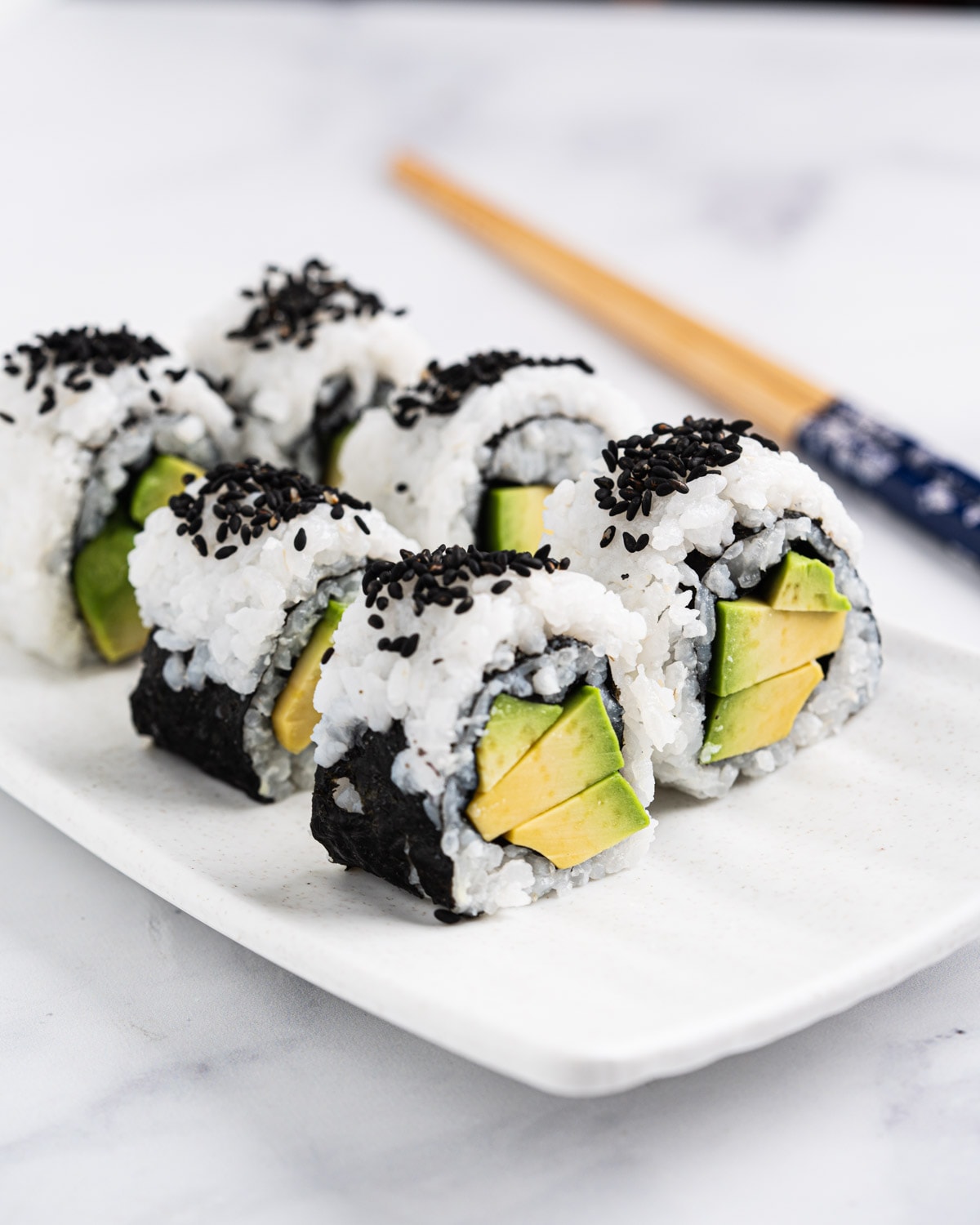
Tips for making the best avocado roll
- Select Fresh Ingredients: Use fresh avocados, ripe but not overly soft. Choose high-quality nori (seaweed) sheets that are crisp and not brittle. Use fresh cucumbers, other vegetables, and seafood if desired to ensure the best flavors and textures.
- Proper Avocado Preparation: To prevent browning, slice the avocado just before assembling the roll. You can brush the exposed surface with a little lemon juice to slow down oxidation. Also, make sure to cut the avocado into thin, even slices for a consistent texture in the roll.
- Use the Right Rice: Use sushi rice or short-grain Japanese rice. Properly cooked sushi rice should be slightly sticky, making it easier to handle and roll. Season the rice with a mixture of rice vinegar, sugar, and salt for authentic flavor.
- Use Plastic Wrap: Use plastic wrap to cover the bamboo sushi mat for easy cleanup. You can also use it to wrap the sushi roll before cutting so that the rice doesn’t stick to your hands. Alternatively, you can also wet your hands with water to prevent it from sticking.
- Rolling Technique: Start by placing a bamboo sushi mat on a clean surface and covering it with a sheet of plastic wrap. Lay a nori sheet shiny side down on the mat, and then spread a thin, even layer of sushi rice over the nori. Add your avocado slices and any other fillings. Use the mat to roll the ingredients tightly into a cylinder, using gentle pressure.
- Sharp Knife and Clean Cuts: Use a sharp, non-serrated knife to cut the roll. Wet the knife with a little water before each cut to prevent sticking and tearing. Make clean, decisive cuts to create evenly-sized pieces that showcase the ingredients beautifully.

Frequently Asked Questions
An avocado roll comprises sliced avocado, seasoned sushi rice, and nori seaweed. It can be served with optional condiments such as soy sauce, wasabi, and pickled ginger.
To determine avocado ripeness, check color – it’s usually dark green or black. Gently squeeze – it should yield slightly without being mushy. Remove the stem – green indicates ripeness, and brown suggests overripeness. Uniformity matters – avoid bruises or dents. Softness near the stem is a good sign. For faster ripening, use a paper bag with a banana.
An avocado roll consists mainly of sliced avocado and sushi rice wrapped in nori seaweed. It may have additional fillings like cucumber or other vegetables, but avocado remains the star ingredient.
A California roll typically contains imitation crab (surimi), avocado, cucumber, and sometimes may include tobiko (fish roe).
Avocado rolls are not part of traditional Japanese sushi. While Japan emphasizes seafood in sushi, avocado’s modern popularity has led to limited adoption, especially in urban areas and among the young. Avocado rolls reflect evolving tastes and cater to diverse preferences, bridging traditional and contemporary culinary influences.
How to store leftover avocado sushi
Wrap and Seal
Wrap the leftover avocado roll tightly in plastic wrap to prevent air exposure and maintain the roll’s shape. Make sure the plastic wrap is in direct contact with the roll’s surface to minimize air contact.
Refrigerate Promptly
Place the wrapped avocado roll in an airtight container or a resealable plastic bag to further prevent air and moisture from affecting the roll. Refrigerate the roll as soon as possible after you’re done eating. Sushi, including avocado rolls, is best consumed on the same day it’s made, but proper storage can help extend its freshness.
Avoid Freezing
Avocado does not freeze well due to its high water content and delicate texture. Freezing can cause the avocado to become mushy and lose its desirable texture. It’s recommended to consume leftover avocado rolls within a day or two.
Serve at Room Temperature
If you’re planning to eat the leftover avocado roll, allow it to come to room temperature for about 15-20 minutes before consuming it. Cold temperatures can dull the flavors, so letting it sit briefly will help enhance the taste.
More Sushi Recipes
RECIPE
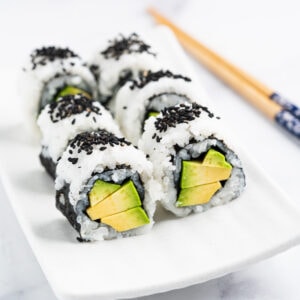
Avocado Sushi Roll
Equipment
Ingredients
- 2 cups cooked sushi rice
- 2 tablespoons rice vinegar
- 1 tablespoon sugar
- ½ teaspoon salt
- 1 ripe avocado (sliced)
- 2 nori seaweed sheets
Instructions
- Prepare the Sushi Rice: Cook the sushi rice according to the package instructions. Once cooked, let it cool slightly.
- Season the Rice: In a small bowl, mix the rice vinegar, sugar, and salt until dissolved. Gently fold this mixture into the slightly cooled sushi rice.
- Prepare Your Work Surface: Place a bamboo sushi rolling mat on a clean surface. Cover it with a sheet of plastic wrap to prevent sticking.
- Assemble the Roll: Lay a sheet of nori seaweed on the plastic wrap-covered bamboo mat, shiny side down. Wet your fingers to prevent sticking and evenly spread a thin layer of seasoned sushi rice over the nori. (Optional: flip the rice-covered nori over.)
- Add Fillings: Place avocado strips in the center of the rice-covered nori.
- Roll the Sushi: Using the bamboo mat, start rolling the nori from the bottom, tucking the filling in as you go. Apply gentle pressure to ensure a tight roll.
- Slice the Roll: (Tip: cover the sushi roll with plastic wrap for easy cutting.) Using a sharp, non-serrated knife, gently slice the roll into bite-sized pieces. It's a good idea to wet the knife between cuts to prevent sticking.
- Serve and Enjoy: Arrange the avocado roll pieces on a plate, and serve with soy sauce for dipping. You can also add optional garnishes like sesame seeds, wasabi, and pickled ginger.
Notes
- Use Plastic Wrap: Use plastic wrap to cover the bamboo sushi mat for easy cleanup. You can also use it to wrap the sushi roll before cutting so that the rice doesn’t stick to your hands. Alternatively, you can also wet your hands with water to prevent it from sticking.
- Rolling Technique: Start by placing a bamboo sushi mat on a clean surface and covering it with a sheet of plastic wrap. Lay a nori sheet shiny side down on the mat, and then spread a thin, even layer of sushi rice over the nori. Add your avocado slices and any other fillings. Use the mat to roll the ingredients tightly into a cylinder, using gentle pressure.
- Sharp Knife and Clean Cuts: Use a sharp, non-serrated knife to cut the roll. Wet the knife with a little water before each cut to prevent sticking and tearing. Make clean, decisive cuts to create evenly-sized pieces that showcase the ingredients beautifully.

